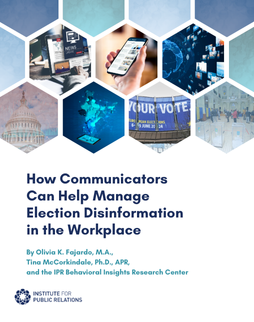This blog is based on the original study in the Public Relations Journal.
The concept of employee engagement is crucial to internal communication practitioners as we enter the third year of the COVID-19 global pandemic. Nearly one-third of surveyed employees across Asia experienced economic hardship and reported daily experiences of worry, sadness, and anger in a Gallup State of the Global Workplace Report in 2021 (Singh, 2021) while businesses in the U.S. were scrambling to deal with the “Great Resignation” during which a record number of employees quit their jobs (Humbad, 2022). Remote working may become a new norm for companies even after the pandemic (McKinsey, 2021).
Public relations practitioners in different countries have previously rated employee engagement in their workplace as a top issue affecting their own daily work (Meng et al., 2013; Tkalac Verčič et al., 2012). These new and fluid realities inevitably underscore the need for a global perspective on employee engagement.
Our study sought to advance theory and practice on employee engagement from a global and qualitative perspective, by examining narratives of employees working for both local and global public relations agencies in China via 24 in-depth interviews. Our main findings revealed a three-dimensional conceptualization of employee engagement: engagement with work, employing organization, and people. Employee engagement is essentially a state of fit. First and foremost, it represents employees’ fit with their job, manifested as individual workers’ responsibility for, dedication to, and fulfillment in job tasks. Engaged employees have a strong work ethic and find meaning and joy in their daily tasks. Their work becomes part of who they are. Secondly, employee engagement is a fit with their organizations. Engaged employees identify with their organizational culture, vision, mission, and values, participate in organizational events and other activities and derive a sense of belonging. This level of fit shows mutually beneficial relationships between employees and organizations. Lastly, engaged employees reported a fit with their coworkers and leaders, showing emotional bonding spanning multiple levels. To our interviewed participants, the workplace resembles family and home. The three dimensions work in tandem to form employees’ overall experience of engagement within an organization as they seek to fit in with their job, their organizations, and with coworkers and superiors. Our study suggests that employee engagement as a matter of fit materialized in these three dimensions could encompass employees’ psychological state for their job, attitudes towards their organization, and perceptions of their work relationships.
While our study confirmed that public relations practitioners in Chinese agencies viewed employee engagement as positive and desirable, some caveats are worth noting. When working exceedingly long hours and sacrificing self-interests for one’s company are normalized and promoted in the name of job engagement and job ownership, employees’ physical health and mental well-being may be jeopardized. Also, emotional bonding and close work relationships may muddle work-life boundaries. A delicate balance of these different aspects is needed as organizations consider engagement initiatives and employees navigate their organizational lives.
Cultural nuances regarding job engagement, the “happy marriage” metaphor and engagement with people are also discussed. For more details about our study, please refer to Ren and Shen (2022).
References
Humbad, A. (2022). Engaging and retaining employees in 2022 by building a sense of community and purpose. Retrieved from here.
Meng, J., Jin, Y., & Hung-Baesecke, F. C. J. (2013). Top issues and responsive strategies in public relations practice: An empirical assessment in the Greater China area. Public Relations Review, 39, 597-599. Retrieved from here.
Ren, C., & Shen, H. (2022). Conceptualizing employee engagement in China: “It’s a state of fit.” Public Relations Journal. Singh, P. P. (2021). How the pandemic affected employees in the south, east, and southeast Asia. Retrieved from here.
Tkalac Verčič, A., Verčič, D., & Sriramesh, K. (2012). Internal communication: Definition, parameters, and the future. Public Relations Review, 38(2), 223-230. Retrieved from here.






